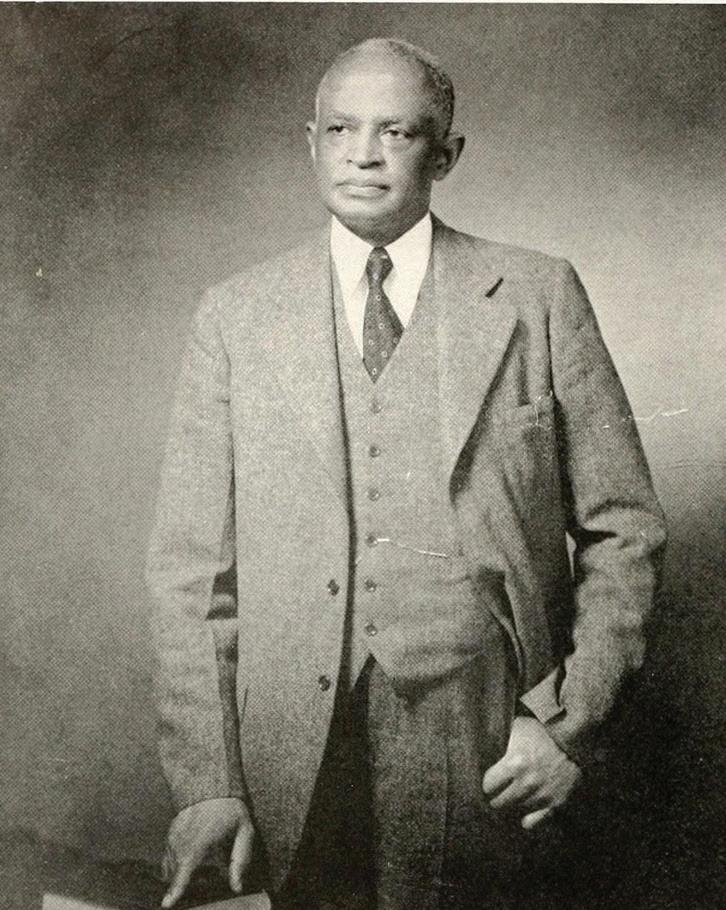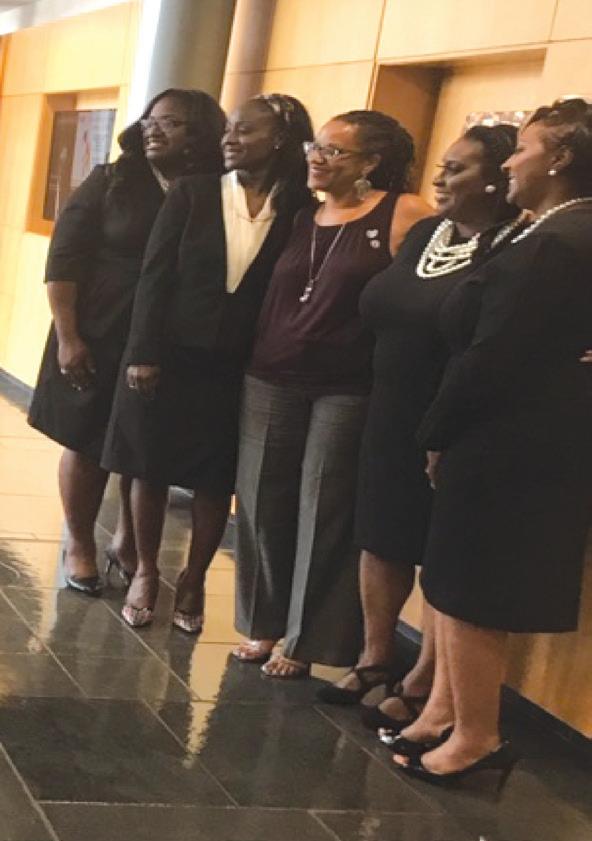
9 minute read
The First Eighty Years and Counting
FIRST THE
AND COUNTING YEARS
Advertisement
BY FINESSE G. COUCH
hen Dr. Shepard envisioned the School of Law, even without a crystal ball, he correctly foresaw the importance of a law school that could produce diverse, practice-ready attorneys. Opening March 1939, the same year The Wizard of Oz movie premiered, Dr. Shepard’s keen insight surpassed mere wizardry with its green smoke and closed curtains. Dr. Shepard’s legislative lobbying efforts eventually
materialized into North Carolina Central University School of Law. On hallowed ground, for eighty years, with dedicated and committed administrators, faculty, staff and students, the School of Law stands prominently among its peers. Still a beacon of light, the School of Law celebrates its first eighty years of successfully providing a quality legal education program to generations of diverse attorneys.
Proud, competent, and capable, like the first graduate, Robert Richard Bond, some graduates have chosen careers in public service, where they have run on to become distinguished judges and legislators. Others have chosen entrepreneurship, education, Legal Aid and the private practice of law where they have evolved into award-winning practitioners and leaders with transformative presences. Interim School of Law Dean Elaine O’Neal, a retired Superior Court Judge and “double eagle”, is one byproduct of Dr. Shepard’s life-changing, vision. Following Dr. Shepard’s example, Law School Administration collaborates with colleagues at other law schools, supporters, alumni, legislators and friends to promote the school’s unique mission. Also Administration has worked closely with its active Alumni Association which has created methods to assist and mentor law students.
Given the first eighty years, one can only ponder the headway the School of Law will make during the next eighty years. Yet looking back, a couple of easy comparisons are helpful in seeing how far society has progressed as the School of Law has grown from its first student to its current 363 student census. For instance, a comparison of the price of necessities for living in 1939 to the price of necessities for living in 2019 seems incredible. Also a similar comparison of the number of lawyers in the United States in 1939 to the number of lawyers in 2019 seems equally amazing! Consider the comparisons in the chart below.

Like the proliferation in the price of necessities for living, a similar comparison of the increase of lawyers in the United States during this time period leaves one equally amazed. According to a United
20K
DOLLAR AMOUNTS
10K
5K
1K
500
100 75
50 25
$28 - for house $1,290.18 $1,023.55 1 bdrm apartment in city centre 1 bdrm apartment outside of centre
$1,639.36 $2,094.40
3 bdrm apartment in city centre 3 bdrm apartment outside of centre
$364,950.00 $263,070.00 $38,479.20 / year
$22,000.00 $20,714.69
$3,800.00
cost of new home cost to buy apartment in city center per square feet - $243.30 ( est . 1500 sq . ft .) cost to buy apartment outside of center per square feet - $175.38 ( est . 1500 sq . ft .) average monthlly net salary ( after tax ) - $3,206.60 $1,730.00 $700.00
volkswagen golf 1.4 90 kw trendline ( or equivalent new car ) toyota corolla 1.61 97 kw comfort ( or equivalent new car )
How Much Things Cost in 1939 Versus 2019 1,2
$0.10 $2.77 $0.14 $5.23 - beef round (1 lb ) or equivalent back leg red meat
$0.08 $2.37 - loaf of fresh white bread (1 lb )
Chart Reflects Average Prices
States 1940 Census Report, the combined number of lawyers and judges around 1939 was 180,483,160. 3 The ABA National Lawyer Population Survey, Historical Trend in Total National Lawyer Population 1878–2018 4 shows 181,220 lawyers in the US in 1940. Then, simply contrast that number with the current number of lawyers in the US in 2019: 1.35 million. 5
In a recent article written by Debra Cassens Weiss published by the ABA Journal, Weiss describes the race and ethnicity of American attorneys. Ms. Weiss states that in recent years, race and ethnicity data have been collected and reported by twenty states to the
NORTH CAROLINA
TEXAS
NEW YORK
ABA. The 2018 reported data shows “85 percent of attorneys identify as Caucasian/White; 5 percent as African-American; 5 percent as Hispanic; 3 percent as Asian; 1 percent as Native American; and 1 percent as multiracial.” According to Ms. Weiss, the states with the largest lawyer populations are not necessarily the same states where lawyer numbers are growing the fastest. States with the “highest percentage of growth over the last decade” 6 were North Carolina (22%), Texas (22%), and New York (19%), with growth rates indicated in parentheses.
Locally, theNorth CarolinaState Bar currently regulates over 28,000 licensed attorneys. 7 In a recently updated Demographic Distribution Report published by the North Carolina State Bar, based on voluntary survey results from 11,675 North Carolina Attorneys, 1054 African American and 261 Latino Attorneys selfreported their race and ethnicity, respectively. 8
Diversity in the judiciary is alive and well among School of Law graduates. Four alumnae/judges were recently featured on Steve Harvey’s national television show, where they discussed the subject of diversity. Law School Alumnae, Judge Shamieka Rhinehart, Judge Camille Banks-Prince, Judge Keisha Wright-Hill and Judge Teresa Raquel RobinsonFreeman’s friendship started in the Law School’s Moot Courtroom. Interviewed by a local news team, the judges discussed the importance of diversity. “It is equally important to have diversity of age which we are all younger in our careers, but also diversity of
thought process and background and experiences,” said RobinsonFreeman. “It’s about justice and justice should include everyone,” Rhinehart added. 9
Throughout the years, law graduates have collaborated with law school colleagues and been recognized for their contributions to the legal community and exemplary leadership. The impressive list of graduates recognized in “So Far, 70th Anniversary, North Carolina Central University School of Law School”, 10 has continued to grow. From the local North Carolina District Court Bench where Judge Pat Evans is Chief, to the State Supreme Court, where Associate Justice Michael Morgan presides, and many other courts, School of Law Graduates are actively presiding, thereby demonstrating the importance of diversity in the judicial arena.
The Law School’s undeniable narrative of hard work and success go hand in hand. One example is the in-depth practical skills training and knowledge law students receive prior to emerging practice ready upon graduation. Consider the school’s outstanding Clinics designed to buttress practical skills and applications of doctrinal and theoretical classroom knowledge. Experiential Learning Outcomes are carefully designed to improve student learning and provide meaningful feedback to students. These Clinical, Simulation and Field Placement Courses have grown to include an array of offerings such as the Alternative Dispute Resolution Clinic, Appellate Advocacy, Arbitration, Civil Litigation Clinic, Consumer Financial Transaction
Clinic, Criminal Prosecution Clinic, Criminal Defense Clinic, Family Law Clinic, Juvenile Law Clinic, Low Income Taxpayer Clinic, Mediation, Negotiation, Patent Clinic, Pathways to Practice, Pleadings and Practice, Trademark Clinic, Trial Practice, and Veterans Law Clinic.
Also, to maintain standards, senior administrators, faculty, staff and students have worked mindfully in compliance with ABA Standards and Rules of Procedure for Approval of Law Schools. The eightieth anniversary finds the School of Law with an ultimate bar passage rate of 81.88 for 2016 and 77.77 for 2017. Senior administration, faculty, staff and students welcomed the ABA Fact Finders’ November 2018 visit, and their subsequent, favorable compliance findings.

Thereafter, senior administrators, faculty and staff prepared and timely submitted mandatory reports prior to the ABA Site Evaluation Team visit in November 2019. The Site Evaluation Team evaluated the School of Law’s operations, policies and procedures; and interacted with senior administrators, faculty, staff and students regarding ABA Accreditation standards, rules and requirements. An extensive written site evaluation report will be issued. The Site Evaluation Team’s report should cover “all aspects of the school’s operation including faculty and administration, the academic program, the student body and its success on the bar examination and in job placement, student services, library and information resources, financial resources, physical facilities, and technological capacities.” 11 North Carolina Central University School of Law looks forward to completing the current
accreditation process, while recognizing reaccreditation will recur in ten years.
Looking ahead, distance education courses will allow onethird of the credit hours required for the J.D. degree 12 to be provided “online”. Through approved distance education courses, the School of Law may award one academic year of course credits toward the threeyear Juris Doctorate Degree. The School of Law may be able to utilize its virtual classroom, synchronous learning environment to this end. Certainly the School of Law will seek to explore this new arena, while fulfilling its important mission. Already delivering services to rural and local partners, this technology and learning environment have yet to reach their full potential. Also, technology may help the School of Law to expand the provision of a quality legal education program, through well-planned distance education coursework with other law schools and universities. Adding the distance education component will help students and the school save time, money and resources, thereby enhancing the School of Law’s effective presence in this new arena.
The next eighty years: more collaboration with supporters, friends and alumni to perpetuate Dr. Shepard’s vision of educating future generations of diverse lawyers, judges, legislators and leaders. Reinstating the Board of Visitors, increasing local, regional and national alumni participation and fundraising may help in this regard.
1
2
3
4
5
6
7
8
9
10
11
12
Pearson, Steve. “What Happened in 1939 Important News and Events, Key Technology and Popular Culture.” The People History, Thepeoplehistory.com
“Cost of Living in United States.” Numbeo, 2019
Occupation and Industry Statistics, 1930 And 1940 p 59, Table 3.
Published by the American Bar Association in 2018.
Black, Nicole. “ABA 2019 Report: Lawyer Demographics, Earnings, Tech Choices, and More.” MyCase Blog, 13 Aug. 2019
Weiss, Debra Cassens. “Lawyer Population 15% Higher Than 10 Years Ago, New ABA Data Shows.” ABA Journal, 3 May 2018
“Who We Are.” North Carolina State Bar, www.ncbar.gov/about-us/who-we-are.
“Demographic Distribution Report.” North Carolina State Bar, www.ncbar.gov/aboutus/demographic-distribution-report/. pages 35-41.
“4 NCCU roommates brought together by fate, share journey becoming judges”, https:// abc11.com/4-nccu-roommates-becomejudges-together/4631965/, 11 March 2019.
American Bar Association, Section of Legal Education and Admissions to the Bar, The Law School Accreditation Process, Site Evaluation Process, p 9, 2016 ABA Law School Accreditation Process
Standard 306. Distance Education, ABA Standards and Rules of Procedure for Approval of Law Schools 2019-2020
Finesse G. Couch Interim Associate Dean of Administration North Carolina Central University School of Law fcouch@nccu.edu







